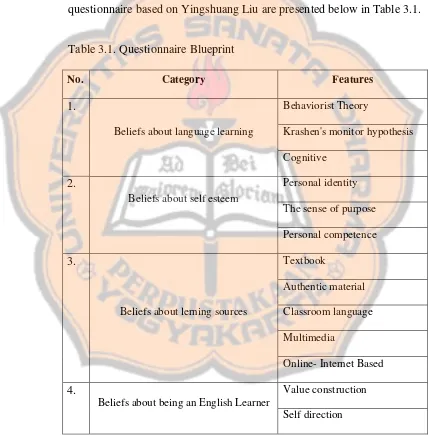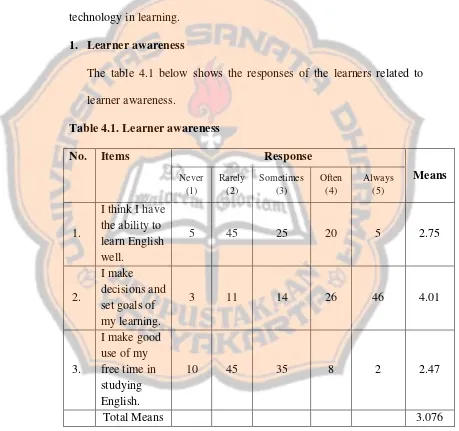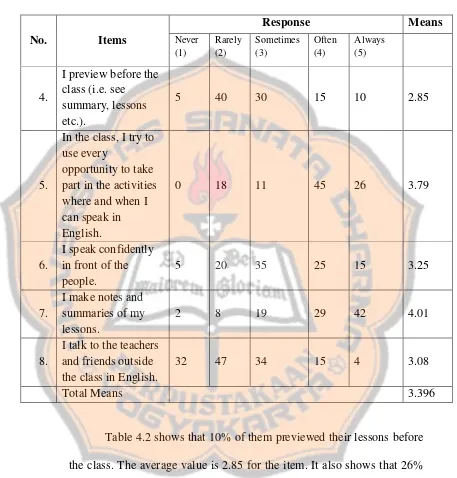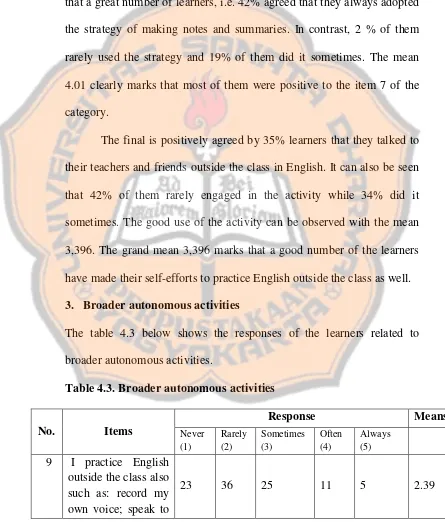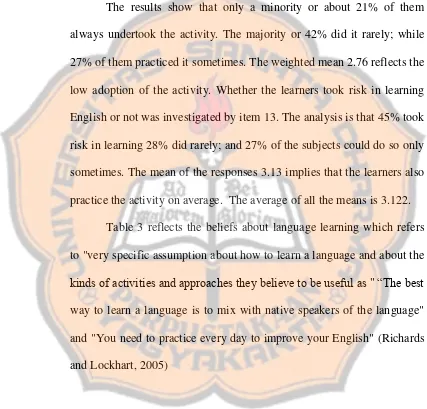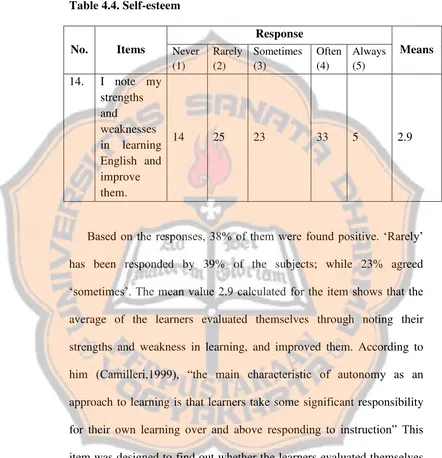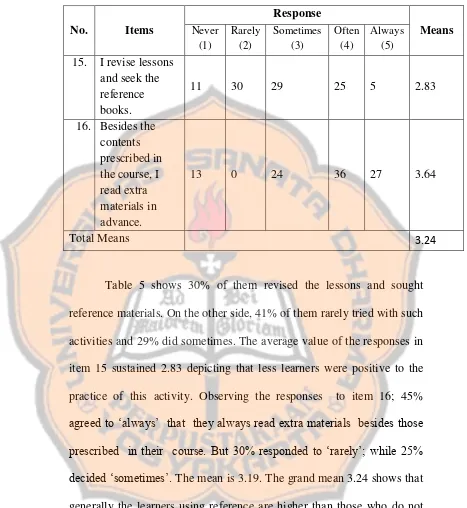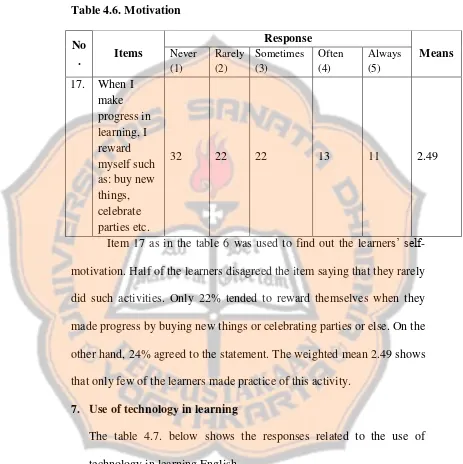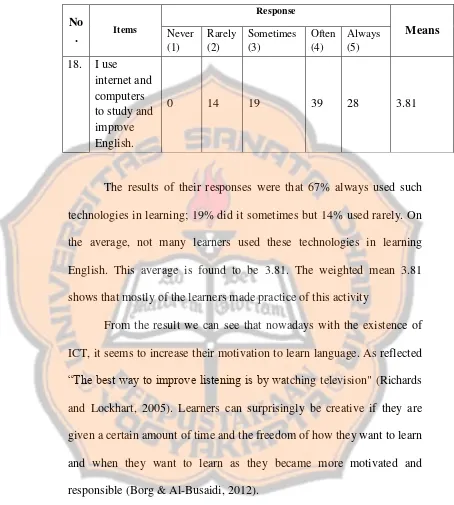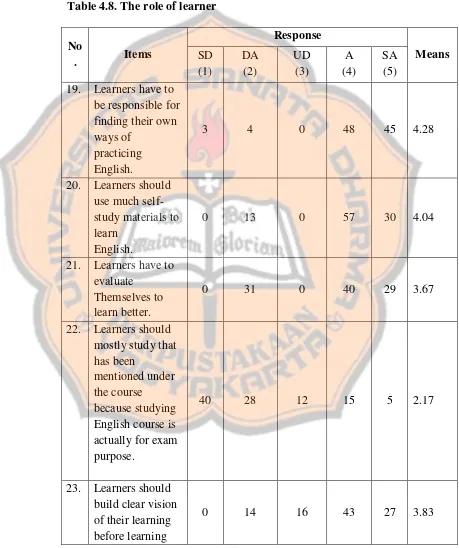ACKNOWLEDGMENTS
First, I would like to thank God, Allah SWT, who has granted me power,
health, safety and an opportunity to continue my education in the English post
graduate program, Everything I get in my life is not separated from His gift and
generosity. In this occasion I also want to thank my parents and my wife who have never been tired to encourage me to be a patient and wise man, and a meaningful person for others.
Second, I would like to express my sincere thanks to my advisor, Mr.
Mukarto (FX. Mukarto, Ph.D.) for his patient guidance and constructive
feedback throughout all the various stages of this research. I am also grateful to
English Language Studies lecturers for the chance to participate in their classes.
Participating in their classes has indeed encouraged me to regard the time,
cooperate with others and increase insight and knowledge.
Third. I wish to thank all my classmates. The learning will never be the same
without you all. Thank you very much for all the support during the study.
Finally. I offer my regards to all of those who supported me in any respect
during the completion of the study. My apology goes to whom unintentionally
LIST OF CONTENTS
TITLE PAGE ... i
ADVISOR'S APPROVAL PAGE ... ii
DEFENSE APPROVAL PAGE ... iii
STATEMENT OF ORIGINALITY ... iv
LEMBAR PERNYATAAN PUBLIKASI ... v
ACKNOWLEDGMENTS ... vi
TABLE OF CONTENTS ... vii
LIST OF TABLES ... ix
LIST OF APPENDICES ... x
ABSTRACT ... xi
ABSTRAK ... xii
CHAPTER I: INTRODUCTION A. Research Background ... 1
B. Problem Identification ... 2
C. Problem Limitation ... 2
D. Problem Formulation ... 3
E. Research Objective ... 4
F. Research Benefits... 6
CHAPTER II: LITERATURE REVIEW A. Theoretical Review 1. Learners Beliefs ... 8
a. Learners beliefs on Language Learning ... 9
2. The Characteristic of Language Learner ... 11
3. Autonomy in Language Learning ... 17
a. Concept of Autonomy ... 17
b. Contrasting Learner Autonomy and Self-Regulated Learning ... 20
c. Autonomy in Language Learning ... 22
d. Characteristic of Autonomous Learner ... 33
B. Conceptual Framework ... 37
CHAPTER III: RESEARCH METHODOLOGY A. Research Method ... 39
B. Nature of Data ... 40
C. Data Gathering Instruments ... 41
D. Data Setting ... 43
E. Data Gathering Techniques ... 47
F. Data Analysis ... 48
G. Trustworthiness of Research Findings ... 48
CHAPTER IV: FINDINGS AND DISCUSSION A. Findings ... 50
B. Discussion ... 65
CHAPTER V: CONCLUSIONS A. Conclusions ... 69
C. Recommendation ... 74 BIBILIOGRAPHY ... 75
APPENDICES
LIST OF TABLE
Table 3.1. The questionnaire blueprint ... 42
Table 4.1. Learner awareness ... 52
Table 4.2. Self-efforts ... 54
Table 4.3. Broader autonomous activities ... 56
Table 4.4. Self-esteem ... 57
Table 4.5. Use of reference materials ... 58
Table 4.6. Motivation ... 59
Table 4.7.Use of technology in learning ... 60
Table 4.8. The role of learner ... 62
LIST OF APPENDICES
Binar Winantaka. 2015. Learners’ Beliefs about Autonomy in Language Learning. Yogyakarta: English Language Studies, Graduate Program, Sanata
Dharma University Abstract
The effective learning is believed will only occur when the learner actively participated in the learning process. The theory and practice of independent learning and learners’ autonomy have become more popular in foreign language learning. The issue of autonomous learning is the main target of this process of learning.
This research was aimed at describing the learners’ belief about autonomy in language learning.. Learners bring their own beliefs, goals, attitudes and decisions to learning and these influence how they approach their learning. Their beliefs about language learning or learner autonomy may vary greatly from one to another. The main aim is to discover whether learners are ready to accept autonomous learning so as to help teachers know more about learners and choose proper methods to guide them promoting learner autonomy
This research reports the results of a descriptive analysis into university students’ beliefs about autonomy in language learning through quantitative research. The participant of the research are 100 university students from different study programs. The data sampling technique used in this research is simple one-stage cluster sampling. The data was collected by using questionnaire. The learners' responses to the questionnaire items were collated, tabulated and analyzed descriptively. The results were presented in percentages
The results of this research show that learners are found to be aware of the goals and the process of learning English, it could be drawn from the mean score of 3.076 out of 5. Another result is that with the means score of 3.396 out of 5 learners or majority of them has done self-efforts to improve and enhance their English. It can be expected that these findings will help English language teachers further understand learner beliefs about Autonomy language learning, which may enable them to achieve successful English teaching and learning.
This research provide description of learners’ beliefs about autonomy in language learning as an attempt to understand learners’ beliefs on English language learning and to empower the learners to develop their sustained autonomous language learning
Binar Winantaka. 2015. Learners’ Beliefs about Autonomy in Language Learning. Yogyakarta: English Language Studies, Graduate Program, Sanata Dharma University
Abstrak
Pembelajaran efektif diyakini hanya akan tercapai bila peserta didik berpartisipasi aktif dalam proses pembelajaran. Teori dan praktik pembelajaran mandiri dan otonomi peserta didik semakin populer dalam pembelajaran bahasa asing. Isu pembelajaran otonom adalah sasaran utama proses pembelajaran ini.
Penelitian ini bertujuan untuk mendeskripsikan keyakinan peserta didik tentang otonomi dalam pembelajaran bahasa. Peserta didik membawa keyakinan, sasaran, sikap dan keputusan mereka sendiri untuk belajar dan ini mempengaruhi bagaimana mereka mendekati pembelajaran mereka. Keyakinan mereka tentang belajar bahasa atau otonomi pelajar bisa sangat bervariasi satu sama lain. Tujuan utamanya adalah untuk mengetahui apakah peserta didik siap untuk menerima pembelajaran otonom sehingga dapat membantu guru mengetahui lebih banyak tentang peserta didik dan memilih metode yang tepat untuk membimbing guru mempromosikan otonomi peserta didik.
Penelitian ini melaporkan hasil analisis deskriptif terhadap kepercayaan mahasiswa tentang otonomi dalam pembelajaran bahasa melalui penelitian kuantitatif. Peserta penelitian adalah 100 mahasiswa dari berbagai program studi. Teknik sampling data yang digunakan dalam penelitian ini adalah sampling cluster satu tahap sederhana. Data dikumpulkan dengan menggunakan kuesioner. Tanggapan peserta didik terhadap item kuesioner disusun, ditabulasikan dan dianalisis secara deskriptif. Hasilnya disajikan dalam persentase
Hasil penelitian ini menunjukkan bahwa peserta didik diketahui mengetahui tujuan dan proses belajar bahasa Inggris, hal tersebut dapat ditarik dari skor rerata 3.076 dari 5. Hasil lainnya adalah dengan skor rerata 3.396 dari 5 Pelajar atau mayoritas dari mereka telah melakukan usaha sendiri untuk memperbaiki dan meningkatkan bahasa Inggris mereka. Dari temuan ini diharapkan akan dapat membantu guru bahasa Inggris lebih jauh memahami keyakinan pelajar tentang pembelajaran bahasa otonomi, yang memungkinkan mereka mencapai proses belajar mengajar bahasa Inggris yang sukses.
Penelitian ini memberikan gambaran tentang keyakinan peserta didik tentang otonomi dalam pembelajaran bahasa sebagai upaya untuk memahami kepercayaan peserta didik terhadap pembelajaran bahasa Inggris dan untuk memberdayakan peserta didik untuk mengembangkan pembelajaran otonom mereka yang berkelanjutan.
CHAPTER I
INTRODUCTION
This chapter presents the background information related to the
importance of this research. This is a replication research by Yingshuang
Liu in 2011 with the same theme, but different setting and respondents.
The discussion will be initiated with the general information related to
learners learning. The focus of the discussion is the learners‟ belief about
Autonomy in Language Learning.
A. Background
Mastering English Language has become more important nowadays
as there is no more distance boundary between people in the world. The
ability of the learners in using English language will be very helpful
for them to improve their knowledge with people around the world. It
has made more people aware of the importance of learning English
language.
Many efforts have been done by education stake holders to make
their learners more effective in learning English. Many factors determine
the success of a language learning process. One of those significant
factors is the individual learner difference such as learners' belief.
Learners' belief is believed to play important roles to language learning
achievement. The understandings of the important roles of the learners‟
belief have attract many researchers to make projects on the matters.
Sharing the similar concern, this research tries to provide a clearer
its local context.
The effective learning is believed will only occur when the learner
actively participated in the learning process. The atmosphere of learning
takes some parts on this when the previous learning process model may
lead to the dependent learning. Most of class activities led to the
dependent behaviors of their language learning. Therefore, it is important
to keep analyzing on the model of language learning process that
appreciates the learners‟ autonomy and the changes in the education
fields. So the learners do not only become the object of the learning
process that passively receives the knowledge but they must actively
contribute to the development of their learning. Even more, it is quite
necessary to equip the learners with the learning tools, then the aim of
education is not as simple as knowledge transfer. Rather, the end of the
product of education is an independent learner (McDevitt, 1997).
The theory and practice of independent learning and learners‟
autonomy have become more popular in foreign language learning. The
issue of autonomous learning is the main target of this process of
learning. Self-learning is one of the suggested ways, the learners are
freely to decide, choose and finally be responsible of their learning. The
learners are allowed to develop their own learning through various media
and various resources. There are many resources which can be used to
optimize their language learning. This research is going to focus on the
investigation of college learners‟ belief about autonomous learning. The
learning so as to help teachers know more about learners and choose
proper methods to guide them promoting learner autonomy.
This research is a replication research by Yingshuang Liu in 2011 with
the same theme. According to Mackey (2012) replication studies using
the original research design are useful in re-examining the theoretical
relationship among constructs. For instance, in a situation where the
original research identified multiple explanations for the results, a
conceptual replication can manipulate nonsignificant variables and
operationalization of the original study to examine the strength of the
causal relationship among variables.
B.Problem Identification
The successful learning process especially in language learning is
depending on some aspects. The individual learner difference such as
learners' belief is one of those key aspects. Some researchers believed
that learners' belief on language learning strategy has a substantial roles
to language learning realization. The raising of the awareness around the
significance of learners‟ belief invites many researchers to study the area.
Having the same concern, to provide a better understanding of learners'
belief for a better English language learning and to deal with the issue of
autonomy in language learning, this research tried to define what
learners‟ beliefs about autonomy in Language Learning especially in
English learning.
C. Problem Limitation
learners embrace a wide diversity of beliefs about language and language
learning and that these may influence learning attitudes and behavior.
Many educators have realized that it is crucial to prepare the learners
with the tool of learning and they also realize that the purpose of
education is not only transmission of knowledge but also promoting the
learners autonomy. Learner autonomy is not only the means to the end of
effective learning, but also the desirable goal of education. No learners,
anywhere, will have their teachers to accompany them through their life (
Littlewood, 1999).
Underlined that learning success depends less on the materials
and teaching techniques and more on what goes inside the learner
(Stevick in Bernat,et al., 2005). This research focused on the area of
belief of language learners about autonomy in language learning and the
contribution of their learning into their progress in acquiring the language
and then autonomous learning done by the learner will be the objective.
This research is a survey research using questionnaire to investigate the
respondents about their beliefs.
D. Problem Formulation
One of implications of understanding learner beliefs in language
learning is that learners‟ beliefs about language learning influence their
affective. So study related to beliefs will be able to offer a reasonable
explanation for the emergence of classroom anxiety. Another implication
is that learners‟ language learning beliefs are believed to influence their
knowledge on their learning beliefs will get rid of ineffective learning
strategies and as a substitute apply effective learning strategies. Learner
beliefs also indicate to some degree learners‟ readiness for autonomous
learning, thus it has a vital role in motivation stimulation and formation
of learner autonomy.
The theory learners autonomy and the practice of autonomous
learning has become increasingly popular in foreign language education,
which has inspired much insightful research (Gremmo & Riley,1995).
According to Holec (1981), learner autonomy is an ability to take charge
of one‟s own learning. Like its forerunner, communicative language
learning, it is starting to be an unquestionable goal and integral part of
language learning methodologies throughout the world (Hayo Reinders,
2010). Therefore, language teachers should consider stimulating learner
autonomy as their primary goal in language teaching, and teach learners
how to take charge of their learning besides teaching them knowledge.
In a word, to study learner beliefs can help teachers know more
about learners and choose proper methods to guide them fostering learner
autonomy. This research describes and interprets the learners‟ belief in
the area of autonomous learning of English. The research, therefore, aims
to answer theoretically and empirically the following question: What is
the learners‟ belief about autonomy in language learning?
E. Research Goals
This research aimed to describe, and interpret, the beliefs of the
answer to the research question theoretically and experientially. This
research also reveals and describes learners‟ readiness for autonomous
learning between learners so as to be more empowered,
self-fulfilling, and autonomous according to the learners‟ belief, which means
they can do what they are supposed to do and they can do it on their own
when they learn.
Learners‟ belief indicates to some degree learners‟ readiness for
autonomous learning, as it reflects their motivation and formation of
learner autonomy. In a word, to study learner beliefs can help teachers
know better about their learners and choose proper approaches to guide
them fostering learner autonomy. The goal of this research is to describe
and interpret the learners' beliefs about autonomy in language learning.
F. Research Benefits
This research may have three scientific benefits to empower learners
and promote their autonomy in language learning. Theoretically, this
research becomes an additional reference on the literature of English
Study in Indonesia, particularly those concerning the language learning
in the institution.
This research may also provide description of learners‟ beliefs about
autonomy in language learning as an attempt to understand learners‟
beliefs on English language learning and to empower the learners to
develop their sustained autonomous language learning. Through the
interpreted result and discussion, this research may contribute in the
CHAPTER II
LITERATURE REVIEW
In this section, the discussion focuses on literature review and
theoretical framework. Several previous research related to the topic of
this research are discussed to support construct understanding of the
study. Theoretical framework is described to get the tentative answers to
the research questions.
A. Theoretical Review
The literatures on related topics are discussed in this section. The
discussion will go around the learners‟ beliefs, the characteristics of
language learner, and then will reveal the depth concept of learners‟
beliefs, the characteristic of language learner, and autonomy in language
learning.
1. Learners’ beliefs
a. Definition of Learners’ beliefs
Beliefs have been a subject of inquiry in a range of fields,
including education, business, medicine, law, anthropology and
psychology. Furthermore, a scan of the literature in this area reveals that
the concept of belief travels under many aliases; for example attitude,
perception, value, philosophy and ideology. Because of this diversity,
defining 'beliefs' is a difficult task.
Beliefs are defined as "psychologically held understandings,
(Richardson in Bernat, 2005), and "said as strong filters of reality"
(Arnold in Bernat, 2005). Belief can then be simply defined as our state
of the mind or our thoughts or our representation of our interpretation of
reality; deeper than merely thought, however, belief possesses causal role
to the believers' behaviors (Arnold in Bernat, 2005). Belief, then,
involves one‟s past (one's previous experiences), present (the
currently-held-belief) and future.
Cotterall (1995) identifies six major belief dimensions based on
learners‟ responses to her questionnaire as; the role of the teachers, the
role of feedback, learner independence, learner confidence in study
ability, experience of language learning, approach to studying. He also
adds that the beliefs and attitudes the learners hold have an important
influence on their learning behavior. They may either contribute to or
impede the development of learning process (Cotterall 1995).
Similarly, Peacock (2001), claims that some beliefs may be
facilitative or detrimental to language learning. Beliefs about one‟s own
motivation and values of English learning, ability, and learning and
communication strategies can be seen as facilitative beliefs. Within the
BALLI framework, some beliefs about foreign language aptitude, the
role of vocabulary and grammar, self-efficacy in speaking English can be
detrimental to learners‟ language learning. Thus, it is important to
understand learner beliefs because successful learners develop insightful
beliefs about language learning processes and their own abilities, which
Horwitz referred to “beliefs” using the terms such as
preconceptions, preconceived ideas, and preconceived notions.
According to Horwitz (1988), there were five main types of beliefs of
foreign language learners as suggested in "Horwitz's Beliefs about
Language Learning Inventory" which are The difficulty of second
language learning in general and the difficulty of learning the target
language, The role of language aptitude, The nature of language learning,
Learning and communication strategies, Motivation and expectations.
b. Belief Formation
socio-cultural Psychology and Cognitive offers each personal
approach concerning the question of how actually belief is formed. In
line to their first claim, the cognitive considers belief "as well-organized
schema (network of connected ideas-) and belief formation is, therefore,
"an individual autonomous act. Each belief, later, bears the mark of the
individual" (Gabillon, 2005). Those belong to this side do not take into
account the context where belief is constructed. Standing against this
view is the socialists which claim that "belief is constructed in the social
context. It would be inconsistent to talk about belief without referring to
the context in which they are shaped" (Gabillon, 2005).
However, in the field of language learning particularly, the two
stances have come into agreement that actually the two are justifiable and
complementary, as what Castellotti and Moore (in Gabillon, 2005: 240)
stress that there are "the social nature of language learners'
interactions between groups in society". Similarly, Gremmo (in
Gabillon., 2005: 240) argues that the society's general vision about
language learning, and the learner's educational past, and that these
personal experiences influence the formation of learners' representations
and language learning culture.
Discussing back to our previous argument, it is wisely reminding
that, again, the differences are not a matter of right or wrong, but more as
a matter of choice: whether one wants to approach belief from its
individuality, or to deal with it from the social psychological perspective.
The nature of duality of belief is not to be further a controversy.
c. Learners‟ beliefs on Language Learning
Horwitz, a pioneer in this field, defined beliefs as 'preconceived
ideas about language learning' (Horwitz 1987). Horwitz's classic study
investigated how common certain beliefs about language learning of the
learners and teachers. She developed and used a 34 Likert-scale item
questionnaire (the Beliefs about Language Learning Inventory - BALLI)
derived from comments which frequently arose in extensive interviews
with learners and teachers.
Nunan (1988), uncovered differences between the beliefs held by
learners and teachers in English language courses. It was posited that one
factor in this mismatch of beliefs was cultural background. Three other
studies into learners' beliefs (Tumposky 1991, Yang 1993, Kuntz 1996)
background and educational setting affect beliefs. All three studies relied
on the administration of the BALLI. Tumposky (1991) concluded that
culture contributes to motivation, while Yang (1993) and Kuntz (1996)
found that ethnicity and culture influence the beliefs held by learners.
According to Gardner & Miller (2002), learners bring their own
beliefs, goals, attitudes and decisions to learning and these influence how
they approach their learning. Therefore, their beliefs about language
learning or learner autonomy may vary greatly from one to another. To a
large extent, the beliefs that learners hold about language learning may
have a significant impact on their learning outcomes. Cognitivists assume
that learning attitudes and behaviors are conditioned by a higher order of
mental representations concerning the nature of language and language
learning.
Learners‟ beliefs, as a part of metacognitive knowledge, exert
either positive or negative effects on learning practice. Learners‟
insightful beliefs about language learning process, their own aptitudes
and the use of effective learning strategies will help their learning and
assist them to improve a more active and independent attitude which
allows them to take care of their own learning. However, uninformed
beliefs about language learning may lead to dependence on less effective
strategies, causing in poor cognitive performance, classroom anxiety and
a negative attitude towards autonomy. Studies in the area of learner
about language and language learning and that these may influence
learning attitudes and behavior.
In summary, learners‟ belief about language learning is to define
as learners' individual opinion or individual thought concerning what
things they assume as right or wrong dealing with themselves as
language learners, the nature of the language being learned, the nature of
an English as foreign language learning process. In this research, those
beliefs are to elicit and record through learners' opinion or feeling
regarding three major components of the difficulty of language learning,
the existence of foreign language attitude, and the nature of language
learning of acquiring English skill.
2. The Characteristic of Language Learner
Learners have certain characteristics which are different from one
another; their characteristics will lead more or less successful language
learning. Learners' characteristic will affect the language acquisition;
extrovert learner and introvert learner will express different acquisition.
Learners' personality will also take an important part in gaining the target
learning. Some learners have a much easier time of learning than others;
there are some characteristics of language learner that influence their
successful of learning. They are intelligence, aptitude, personality,
motivation and attitudes, learner preferences, and learner beliefs
(Lightbown and Spada, 2006). Every element has their own roles on the
learners who have all elements in `good' condition will get their
successful easily.
It is also beneficial for the learners to decide which language
features are going to develop intensively. Basically it is important to
understand learner's aptitude to determine which profile is the strength
and which one is the weakness then use the information to place the
learners on the appropriate learning program. In relation to maximize the
use of Independent Language Learning Center, knowing self-aptitude
will help the learners to decide the way and the aid they will use to.
Other characteristics of language learners is personality, seems
that personality is also play role on the successful of the language
learners. There are some aspects of personality such assertiveness,
adventurousness, inhibition, self-esteem, empathy, dominance,
talkativeness, and responsiveness (Lightbown Spada ,2004). Every aspect
is supporting each other in the learner's personality and then the
personality will support other learner's characteristic and finally it will
contribute in the achievement of foreign language learning.
Motivation and attitudes are also part of language learner's
characteristics. Positives attitudes and motivation are related to
successful second language learning (Gardner 1985). Motivation in
second language learning is a intricate phenomenon which can be distinct
in terms of two aspects: learner' communicative needs and their attitudes
second language in a wide range of social situation or to achieve
professional motivation, they will perceive the communicative value of
the second language and will therefore be motivated to acquire in it.
Likewise, if learners have favorable attitudes towards the speakers of the
language, they will need to contact with them.
Motivation in language learning is divided into two that is
intrinsic and extrinsic motivation. Motivation to perform an activity
simply for the pleasure and satisfaction that accompany the action called
intrinsic motivation; the learner performs based on their own willingness.
In this case, the learner is willing to find delight in learning a new way to
express their idea in the target language. Extrinsic motivation is
motivation that come from everything around the learner, for example
social demands. Gardner and Lambert in Lightbown and Spada (1999)
created the terms integrative motivation to refer to language learning for
personal growth and cultural enrichment, and instrumental motivation for
language learning for more immediate or practical goals. The result of
the study showed that these types of motivation are related to success in
language learning. Generally type of motivation determines the
performance or the way or the attitude of the learners in their learning
language.
Other characteristic of language learner is learner preferences. In
this case, learner has clear preferences for how they go about learning
new material. The term „learning style' has been used to describe an
and retaining new information and skills (Lightbown and Spada,1999).
There are differences on the style of learning, seems this really
individually. Basically there are three categories of learning style such as
visual, auditory and kinesthetic and every style has its own strength and
weakness, this will affect to the way of learning.
Here are some characteristics adapted from Brown about good
language learning (2007)
a. Low inhibitions
A good language learner tends to feel secure enough to be able to
lower their inhibitions. He or she may create a new second language
identity to experiment with second language (Brown, 2007; Lightbown
and Spada, 2006). However, Different studies on inhibitions have
highlighted terminological uncertainty (as to what „inhibitions‟ really
are), and have not been able to confirm any claims. (Scovel: 2001, in
Brown 2007).
b. Risk taking ability
A good language learner tends to take more risks. Without risks,
there would be an absence of error and therefore an absence of learning
(Brown, 2007). In other hand Learners who are very cautious and take
few risks can also excel in certain learning environments (Lightbown and
Spada 2006). It is arguable as to how much of risk should be considered
optimal.
c. High self-confidence
autonomy. A good language learner tends to have the confidence to take
responsibility for their own learning progress (Rubin and Thompson,
1982, in Brown 2007).
d. Intrinsic motivation
Intrinsic motivation to communicate in second language is likely
to enhance learner‟s learning experiences (Skehan, 2001, in Candlin and
Mercer 2001). Brown stated that ‟intrinsic and extrinsic factors can be
easily identified‟ and that a teachers „ultimate quest‟ is to „harness the
power of intrinsically motivated learners‟ (2007).
e. Cooperative learning skills
A good language learner, commonly through group activities or
pair work, tends to produce comprehensible second language with their
language learning peers (Brown, 2007).
f. Right-brain processes
A good language learner tends to utilise right-brain processes in
order to communicate at a level beyond their current metalinguistic
knowledge. Right-brain processes may help the learner comprehend
whole chunks of the target language as well as help the learner reproduce
the „melody‟ of the target language when they speak (Brown, 2007).
g. High ambiguity tolerance
A good language learner tends to not feel overwhelmed by
ambiguity, rather they regard ambiguity as an opportunity to seek
clarification and to understand more about the different communication
2006).
h. Intuition
A good language learner tends to use their intuition to understand
the contents and contexts of the target language. The learner‟s intuition is
used to compensate for what they have not learnt about the target
language (Brown, 2007).
i. Error feedback processing skills
A good language learner tends to learn the target language,
including pragmatics, through a process of assessing their own trails and
errors (Brown, 2007).
j. Personal goals
A good language learner tends to be clear about what they want to
accomplish (Rubin and Thompson, 1982, in Brown 2007). Also,
„successful language learners tend to take charge of their own attainment,
proactively seeking means for acquisition‟ (Brown, 2007).
a. Concept of Autonomy
Autonomy is the capacity of a person to take control over his or
her own learning. Everyone has their own capacity which is different
from one another for different case. It means that everyone will have
their own policy to cover any problem arise in their life. In this case,
autonomy is quite similar with the notion of independent, where
everyone is freely to make sense of their own case. According to Benson
control has various aspects, autonomy may take various aspects. It
greatly depends on the individual personality.
Autonomy as the freedom and ability to manage one's own
affairs, which entails the right to make decisions as well (Scharle and
Szabo, 2000). In this sense of autonomy, the value of responsibility is
powerful enough. Learner may take or make an action with the
comprehension that they have to be responsible of what they do although
in this case, what learner do belongs to the notion of contributing the
learning. Means that learner tries to be involved in learning, it is also can
be seen as autonomous behaviors in the sense that they act
independently, not waiting to be told what to do.
It is an important element in SLA because it activates the learning
process through learners‟ agency and leads the system beyond the
classroom. Paiva (2011) holds, “Autonomous learners take advantage of
the linguistic affordances in their environment and act by engaging
themselves in second language social practices” (p.63).
Autonomy as a socio-cognitive system is not a state but a
no-linear process which go through variability. Thus, autonomous
learners take benefit of the linguistic affordance in their situation and act
by engaging themselves in second language social practices. Therefore,
being autonomous, in initial state, involves being scaffolded by teachers
in order to improve the process of learning. Without this, it would be
attract institutional commitment. In the meantime, teachers, of course,
need to experience autonomous learning themselves and need to be
committed to self-development.
Learning can only happen if there is willingness to contribute,
although all necessaries in learning are provided. Then, it is clear now
that responsibility and autonomy are plays role. The matter is on the
degrees which are vary from one learner to another, but at least it can be
a starting point to help them become more autonomous.
In relation with the research which tries to find any autonomous
learning of English. among learners through Independent Language
Learning Center, the issue of autonomy is very close because the
activities done in Independent Language Learning Center need learner's
feel independently. Independent Language Learning Center as a means of
facilitating self-directed learning, Independent language learning centers
have proliferated to the point where “self-access language learning' is
often treated as a synonym for self-directed or autonomous learning”
(Benson.2001). Indeed this opinion seems true because learning in
self-access Center means learning without any assistance, they have to make
a plan, do and evaluate themselves, work in Independent Language
Learning Center will automatically lead to autonomy. So it can be
modes of learning.
Learner autonomy is found to be a multipart concept not only
from the semantic view point, but also for some other reasons. It covers
concepts from different disciplines of study (e.g. philosophy, language,
politics etc.). Benson (1997) makes announced distinction between „
self-directed learning‟ and „learner autonomy‟. For him, „self-directed
learning‟ is learners‟ global capacity to learn; while „autonomous
learning‟ is the specific personal characteristic associated with such a
capacity. Nevertheless the term learner autonomy has been seen as
synonymous with individualization. According to him, there are a
number of terms related to autonomy, which can be distinguished from it
in various ways.
Most people now agree that autonomy and autonomous learning
are not synonyms of instruction, access; study,
self-education, out-of-class learning or distance learning (Benson, 2001).
These terms refer to various ways and degrees of learning by oneself;
while autonomy refers to abilities or attitudes. The point is then that,
learning by oneself is not the same thing as having the capacity to
learn-by oneself. Thus, the complication exists at the semantic level.
As a result, it can be determined that autonomy is a complex
socio-cognitive system, subject to internal and external limits which
establishes itself in different degrees of independence and control of
willingness, decision-making, choices, planning, actions and assessment
either as a language learner or as a communication inside or outside the
classroom. By means of a complex system, it is dynamic, chaotic,
unpredictable, non-linear, adaptive, open, self-organizing, and sensitive
to initial conditions and feedback. As of this complexity, there have been
several misunderstandings about the definitions of autonomous language
learning.
Furthermore, Esch (1996) explains what autonomy does not
mean: Autonomy is not self-instruction learning without a teacher; It
does not mean that intervention on the part of a teacher is banned; It is
not something teachers do to learners; It is not a single easily
recognizable behavior; It is not a firm state attained by learners
permanently. The other reason why it is misinterpreted is the many-sided
nature of concept. It consists of a number of elements. The study of
language acquisition consist of wide range of areas. Some of them are
discussed under the situation for its application.
In literature, there are a number of synonymous terms of
autonomy. For some authors, the terms: - learner autonomy, autonomous
learning, learner responsibility, self-directed learning, life time learning
and learning to learn are synonymous. Methods which assist learners to
learn are described in several terms, the most common ones are:
self-directed learning, self-instruction, independent learning and self-access
between them, there are more similarities than differences. Both of the
approaches encourages learners to set and pursue their personal language
learning objectives. Though all these approaches are used as the same
sometimes, they need to be distinguished from each other.
b. Contrasting Learner Autonomy and Self-Regulated Learning
Under a sociocultural angle (Benson, 2007), learner autonomy is
constructed during one‟s negotiation with his/her living environment.
That is to say, this perspective lays the emphasis on the interactions
between learners and their environment. Being in a society, an individual
needs to deal with different matters, people, and relationships, and
learner autonomy is acquired throughout the implementation of these
processes. This perspective acknowledges the impact of both personal
and situational attributes in forming and developing learner autonomy.
Teachers adopting this perspective often provide learners with more
contextual choices, negotiation, and interactive activities (Benson & Chik
& Lim, 2003; Dang, 2010; Ho & Crookal, 1995 ).
In the literature on learner autonomy in language learning it is not
uncommon to see references to self-regulated learning. These references
suggest a tendency to conflate the two constructs. This is not surprising
given that on the surface learner autonomy and self-regulated learning
appear to be similar in as much as both emphasize learner control and
metacognition. Nonetheless, they remain two separate areas of inquiry.
What is surprising, given their shared interests, is the lack of attempts to
in one area might inform work in the other (Lewis & Vialleton, 2011;
Loyens, Magda, & Rikers, 2008).
Two notable exceptions are Lewis and Vialleton (2011) and Loyens
et al. (2008); in the case of the latter the comparison was with
self-regulated learning (SRL) and self-directed learning (SDL). SDL can be
viewed as a manifestation of learner autonomy in which learners accept
responsibility for all the decisions related to their learning (Dickinson,
1995), such as those relating to setting goals, selecting materials,
determining strategies and activities, monitoring and assessing their
learning.
As one would suspect, Loyens et al. (2008) concluded that “SDL and
SRL have similarities with respect to active engagement, goal-directed
behavior, metacognitive skills, and intrinsic motivation” Despite these
similarities, they note that the two terms cannot be used interchangeably.
While SRL is usually considered as learner‟s characteristic, SDL is both
learner‟s characteristic and a design feature of the learning environment.
Further, SDL entails more learner control over the learning environment
and provides a crucial role for the learner in initiating a learning task
(Loyens et al., 2008).
In regard to learner initiation of the learning task, in SRL there seems
to be a general tendency for the teacher to set the learning task and within
those parameters learners have varying degrees of freedom to select
area of learner autonomy in accordance with Holec‟s (1981) model,
learners are expected to assume responsibility for determining the
learning task.
c. Autonomy in Language Learning
This broad definition related to learner autonomy has been the
one most cited in the research (Benson, 2007). There are four
characteristics in Holec‟s (1981) definition. First, autonomy is an ability
to take charge of one‟s own learning which means learner autonomy is
an attribute of learner, not the process . Second, this attribute is not
innate or in - born but necessarily is acquired through systematic
and purposeful learning process. Third, it describes a potential
capacity to act in a learning situation, and not the actual behavior of an
individual in that situation. In other words, learner autonomy cannot
be identified as one single simple behavior in a particular learning
situation. The fourth feature is related to learners‟ ability to take
control of their learning by becoming responsible for the decisions
made in all the aspects of the learning process. This definition
highlights „responsibility‟ and „capacity‟ as key features of learner
autonomy. From this broad definition, many definitions of learner
autonomy have followed.
The successful of learning depends on the response which is
given to the stimuli. If it is done again and again, it will format a habit.
because of the environment is not the origin of the language. So there is
stimulus and response in their environment of learning. According to
behaviorist view, language learning is seen as a habit formation (Mitchell
& Myles, 2004).
Some approaches to educational psychology, humanism,
constructivism and cognitivism had a profound impact on the advocacy
of autonomous learning. Humanism, in particular, has promoted the
growing recognition of learner autonomy. Humanism focuses on the
positive aspects of the people, their inner-directed conscious motivation
and self-directed goals, which stresses understanding, personal
assumption of responsibility, and self-realization (Stevik, 1990).
Rogers proposes that educational objective is to develop human‟s
adaptability and autonomy, and which has important implications for
education (Rogers, 1983). According to him, learners can take their own
responsibilities for their spontaneous activities, use their experiences
freely and creatively, and cooperate effectively with others.
The objective of education is the facilitation of learning, and
learning how to learn is more important than just being „taught‟ by a
teacher who unilaterally decides what shall be taught. Rogers‟ theory has
contributed significantly in recent years to the redefinition of the
educational process, and meanwhile, has inspired many a teacher to
consider the importance of the empowerment of learners in classrooms
Strongly associated to humanism, constructivism is also
concerned with the individual‟s personal meaning or experience, which
suggests the view that individuals should reorganize and restructure their
experience rather than internalizing or discovering objective knowledge.
In Candy‟s terms (Candy, 1991), constructivism “leads directly to the
proposition that knowledge cannot be taught but only learned (that is,
constructed)”, because knowledge is something “built up by the learner”.
Additionally, language learning does not involve internalizing sets of
rules, structures and forms; each learner brings their own experience and
knowledge to stand on the target language or task at hand. For
constructivists, learning is viewed as a self-regulatory process of actively
constructing new understanding from the learner‟s experience, prior
knowledge and collaboration with others.
The teacher assumes more of a facilitator‟s role and the learner
takes on more ownership of the ideas, thus the learner is brought into the
central focus, and this is one of the most important features of
constructivist learning (Duffy et al. 1991). The constructivist theory has
recently been related to the field of autonomy primarily through the work
of David Little (1991, 1994). The key idea that autonomy in language
learning has borrowed from constructivism is that effective learning is
active learning, i.e., learners actively involve themselves in various
stages of learning process, such as setting goals and monitoring their own
work. After all learners are responsible for their own learning in
closely related to cognitive psychology, which emphasizes learners‟
mental processes (Wenden, 1997). The development of learner autonomy
gains support from the notion that knowing and thinking develop with
experiences.
However, in fact, due to exam oriented basis, learners‟ motivation
and learning objectives are not parallel and bounded to the faith in
authorities of teachers and textbooks that hinders learners intrinsic
motivation due to extrinsic goals such as grades and task completion
(Borg & Al-Busaidi, 2012).
Perspectives that researchers have employed to explore learner
autonomy. Benson (1997) attempted to systemize learner autonomy by
introducing the idea of different versions or perspectives of representing
the idea of learner autonomy including: technical, psychological, and
political, which now seems to be a standard model for any discussion
about learner autonomy.
The technical perspective emphasize the situational conditions
under which learner autonomy may develop. “Research adopting this
perspective values attribute s from the learning environment” (Benson,
1997) . Morrison (2008) adopting this perspective have been conducted
in self - access learning centers where authentic materials and
personalized learning activities can foster learner autonomy.
With its emphasis on external conditions, this perspective has its
autonomy factors in a particular learning situation. However, if a
researcher took only a technical perspective on autonomy, it would be
not complete as Oxford (2003) contended that “without psychology, the
technical perspective would be inert”. With the psychological
perspective, some researcher s ( Benson, 2007) take learners‟ ability or
capacity into account. Little‟s (1995) definition involves an element of
awareness (cognitive factor) in that capacity. Benson (2001) considered
learner autonomy as a capacity consisting of two interrelated elements,
namely „behavioral‟ and „(Meta) cognitive‟. These two elements allow
learners to „initiate, monitor, and evaluate‟ their learning processes. This
perspective fits closely with Oxford‟s (2003) who stated that “the
psychological perspective examines mental and emotional characteristics
of learners who are viewed as individuals or members of a sociocultural
group”.
Pennycook‟s (1997) work illustrates this perspective, where
context refers to ideologies and attitudes found in specific locations,
situations, groups (related to age, gender, religion, and culture),
institution s, and socioeconomic levels . The difficulty of defining learner
autonomy in terms of its most important components has also been
expressed by two assumptions: the “degrees of learner autonomy” and
the “behaviours of autonomous learners” (Nunan, 1997). A number of
researchers (Benson, 2001; Nunan, 1997) have attempted to define the
notion that autonomy is a matter of degree. Nunan (1997) argued that
levels of learner actions: “awareness, involvement, intervention,
creation, and transcendence”. At the awareness level, for example,
learners would be “made aware of the pedagogical goals and contents of
the materials”, “identify strategy implication of pedagogical tasks”, and
“identify their own learning styles”. At the other end of the spectrum, in
the transcendence level, “learners would make links between the content
learnt in the classroom and the world beyond” and “become teachers and
researchers”.
Nunan (1997) contended that “most learners do not come into
the learning situation with the knowledge and skills to determine content
and learning proccesses which will enable them to reach their objectives
in learning another language” and that “fully autonomous learners are a
rarity”.
Nunan (1997) suggested that teachers need to encourage learners
to become autonomous and, for the purpose of the current research, this
best takes place in the language classroom. Littlewood (1999) classified
learner autonomy into two levels: proactive autonomy and reactive
autonomy. Proactive autonomy is where learners are able to plan,
monitor, and access their learning. In this way, learners establish their
own “personal learning agenda” and their own “directions for learning”.
This level of autonomy is often seen as the autonomy generally attributed
to learners in Western cultures, such as Australia.
However, in education in general and in language education in
pay attention to the second level called “reactive autonomy”. Reactive
autonomy is “the kind of autonomy which does not create its own
directions, but once direction has been initiated enables learners to
organize their resources autonomously to reach their goal”. Reactive
autonomy is seen as a lower order autonomy than proactive and is
considered a preliminary step towards proactive autonomy. For instance,
if a learner is in a state of reactive autonomy, s/he will learn vocabulary
without being pushed and may volunteer to form a reading group to deal
with assignments.
It can be inferred that with reactive autonomy the level of
decision making in class merely complements rather than challenges the
traditional structures of knowledge and authority. This classification is
worth attention in Asian educational contexts where the concept of
learner autonomy is only recently being explored and where one must
consider cultural and social constraints that are different to those of
Western cultures (Benson, 2000; Little, 1997; Littlewoods, 1999).
However, in one study, Dang (2010) examined the relationship
between autonomy and language proficiency at a university in Vietnam
and found a positive relationship between the two. In the current
research, the study focuses on fostering learner autonomy in foreign
language learning in Vietnam, where the learners‟ level of English is
quite mixed. Additionally, these learners are generally seen as „passive
learner s‟
learner autonomy to explore the educational context for developing
learner autonomy. Although there are different definitions of learner
autonomy in the world, Sinclair (2000) pointed out some common
characteristics of learner autonomy which are generally agreed. These
include that autonomy is a construct of capacity which is not inborn ;
autonomy consists of learners‟ willingness to be responsible for their
own learning ; there are degrees of autonomy which are unstable and
changeable ; autonomy can occur both inside and outside the classroom ;
autonomy has a social as well as an individual dimension ; and that
promotion of autonomy needs conscious awareness of the learning
process .
Rather than being interested in how knowledge is acquired, the
focus is on how knowledge is constructed (Von Glasersfeld, 2004) .
Although researchers may approach issues and factors affecting learning
and learners differently, the theories that umbrella their research is
constructivism (Von Glasersfeld, 2005) . For teachers, helping learners
develop learner autonomy requires attention paid to the negotiation and
support their learners. In order to foster learner autonomy, the
autonomous learners must be willing to be involved in their learning.
This means that they must be motivated and active towards their studies.
As Dam (1995) identified, an autonomous learner as : an active
respondent in the social processes of classroom learning. An active
interpreter of new information in terms of what s/he already and uniquely
situation s/he may encounter at any stage in his/her life (p. 102).
However, in order to be willing to learn, it is important for learners to
understand the tasks they have been given to do, which calls on the
importance of the teacher in the process. Second, when they are willing
to learn, it is important to know how to learn and how to take the
responsibility.
Wenden (1991) emphasized the importance of learner training in
how to learn, suggesting that even „successful‟, „expert ‟ or „intelligent‟
learners have learned how to become autonomous. All learners have to
acquire effective learning strategies, knowledge about learning, attitudes
that enable them to use their skills and knowledge confidently, flexibly,
appropriately and independently of a teacher. And when they can do this,
they are autonomous learners.
Put another way, if learners are willing to learn and have
strategies to take control, they will become autonomous. Little (1995)
stated that autonomous learners are motivated learners. Motivated
autonomous learners are able to apply their knowledge and abilities
further. In the context of English language learning, autonomous learners
can freely apply their language and skills outside the immediate situation
of learning.
The main idea of autonomous language learning is to emphasize
the role of learners rather than teachers by focusing on the process rather
than the outcomes. Teachers should start to acknowledge the fact that
not mean losing their authority in the classroom. Autonomous language
learning should be viewed as the collaborative effort that will empower
learner oriented teaching (Brown, 1994) and the importance of teachers
roles should never been neglected or hindered since the responsibilities
of learning should be shared equally between teachers and learners.
Autonomous language learning should be able to encourage
learners in identifying and developing their learning objective and
introduced them with the notion and practices of lifelong learning
(Jacobs & Farrell, 2001; Camilleri, 1999 Little, 1991; Dam, 1995;
Nunan, 1997; Benson, 2001). Teachers indicated that most of the learners
do not have the ability to identify language concepts on their own that
they rather wait for their teachers to inform them or to teach them the
concepts.
However, sharing goal setting and decision making will actually
encourage learners in taking responsibilities or taking charge on their
own learning and but the teachers possess lack of awareness in regard to
the importance of these two activities during learning session. The
teachers need to realize that some learners might not be learning anything
unless they has a clue on what they are trying to achieve (Cotterall,
2000). At the end, the learners might feel lost and they will neglect
self-evaluation process during ELT session resulting them to be unaware of
their strength and weaknesses toward their learning This condition
ESL classroom (Reinders & Lazaro, 2011; Al Asmari, 2013).
Autonomous learners can practice it in several ways. To enhance
their learning, they can use the various ways and modes. Benson (2007)
summarizes the followings modes of autonomy beyond the classroom:
Self-Access: To foster autonomy, various self-access centers have been
established around the world. These centers provide essential materials
where the learners work on their own to learn from the material provided.
Self-access is an approach to learning not an approach to teaching.
Tandem learning, in which two people are learning each other‟s‟
language work to help one another, has long association with autonomy
(Benson, 2007).
There can be several such modes of practice, for example,
self-study, library self-study, group learning and so on. Learners not only are
found to be independent beyond classroom but also inside the class.
Autonomy in the field of language learning has influenced of variety of
approaches of language learning. Some influences on language learning
autonomy are political philosophy, personal autonomy, educational
reform, freedom in learning, Self-directed learning, Adult Education, and
Psychology of learning constructivism. (Michell, R. and Myles, F. 2004).
d. Characteristic of Autonomous Learner
Still talking about language learners' characteristic, Learner
beliefs is other language learning characteristic which also influent the
language learning. Language learners are not always aware of their
how their instruction should be delivered. These beliefs are usually based
on their previous learning experiences and the assumption on the
particular type of instruction is the best way for them to learn (Lightbown
and Spada, 1999). Learner's preferences for learning, whether related to
their learning style or their beliefs on the way the languages are learned,
will influence the selection of strategy to learn new material.
There are several researches which try to profiling autonomous
language learner. There are more than 100 competencies associated with
autonomy in learning, which grouped into 13 headings. One of the most
substantial attempts to list the characteristics of the autonomous learner
comes from beyond the field of language education in Candy's (1991) list
of more than 100 competencies linked to autonomous learning in the
educational literature In the context of language education, Breen and
Mann (1997) offer a reduced set of characteristics, suggesting that
autonomous learners:
1) see their relationship to what is to be learned, to how they will
learn and to the resources available as one in which they are
in charge or in control;
2) are in an authentic relationship to the language they are
learning and have a genuine desire to learn that particular
3) have a robust sense of self that is unlikely to be undermined
by any actual or assumed negative assessments of themselves
or their work;
4) are able to step back from what they are doing and reflect
upon it in order to make decisions about what they next need
to do and experience;
5) are alert to change and able to change in an adaptable,
resourceful and opportunistic way;
6) have a capacity to learn that is independent of the educational
processes in which they are engaged;
7) are able to make use of the environment they find themselves
in strategically;
8) are able to negotiate between the strategic meeting of their
own needs and responding to the needs and desires of other
group members.
One observation that can be made about these kinds of checklists is that
the components described are often of very different orders, ranging from
skills to aspects of attitude and personality. This raises an initial question
of whether the autonomous learner is someone who has acquired certain
attributes or simply a person with a certain personality and approach to
learning and life. It is also possible that both are involved and, if so, we
will need to separate out the attributes that make up autonomy from the
factors of attitude and personality that may predispose individuals
that are specific to autonomous learning from those that simply describe
'good' learning. Lastly, it seems important that we make a distinction
between description of what autonomous learners are capable of doing
and description of the psychological competencies that underlie these
capabilities.
One of the main arguments is that we can describe what autonomous
learners are capable of doing in terms of control over various aspects of
their learning. While it is difficult to say how many aspects of learning
need to be under the learner's control in order for the learner to be
considered autonomous, there must at least be some degree of control
over the content of learning. Whether learners are able to control the
content of their learning or not is partly a matter of their own capabilities,
but also partly a matter of the circumstances in which they are learning.
The capacity to control one's learning is, in principle, independent on the
act of controlling it, but it also seems unlikely that someone will develop
this capacity without ever having had the opportunity to exercise it. This
points, perhaps, to a more holistic view of learner autonomy as a broad
capacity to control those aspects of learning that are particularly salient to
the learner, the learner's goals and purposes, and the context of teaching
and learning. The question remains of whether we are able to identify
certain core competencies that underlie this broad capacity to control
learning flexibly, in response to contextual needs and constrains. If such
competence do exist, they are probably best described at a relatively broa
resources, reflection and metacognitive knowledge. According to Candy
(1991) in Benson, 2001, the learner capable of autonomous learning will
characteristically as follows:
1) be methodical and disciplined,
2) be logical and analytical,
3) be reflective and self-aware,
4) demonstrate curiosity, openness and motivation,
5) be flexible,
6) be interdependent and interpersonally competent,
7) be persistent and responsible,
8) be venturesome and creative,
9) show confidence and have a p
